I’m a Watford season ticket holder of 25 years. There, I said it.
With that in mind, writing a positive data analysis of what makes Luton Town’s crop of 2022-23 so good is something that’ll undoubtedly make me a pariah to many Watford fans in a normal week (sorry dad), let alone in the week leading up to a crucial M1 derby match at Kenilworth Road.
But the fact is, this Luton team are very effective. Not just that, they are one of the strongest Championship teams of the season – arguably the best if you were to generate a club ‘resources to points won’ calculation.
If you’d have told a fan of either club at the start of the season that Watford’s newly appointed manager would be in charge of Luton a month before Christmas, nobody would have believed you. But it’s happened and Rob Edwards is proving his old club wrong as he sends Luton soaring up the table. Here’s how he’s doing it.
The Unorthodox Path to Luton
There really isn’t much love lost between Luton and rivals Watford, so for a manager to cross the divide (albeit after being sacked by the other) is very rare and usually unwise. So far though, it’s a move that has worked wonders for Rob Edwards.
Edwards was picked as the man to lead Watford into a new era – a young, progressive head coach who would be backed ‘come hell or high water,’ but it turned out that hell and high water came quicker than expected at Vicarage Road and the panicked board dismissed him after just 10 league games in charge and three wins on the board. In truth, the partnership rapidly looked incompatible, and it was best for both parties to split.
The former Welsh international was picked by the Hornets following a fantastic season at Forest Green Rovers, where he won the League Two title and was named the 2021–22 EFL League Two Manager of the Season. At the Gloucestershire club, Edwards embedded a fast, dynamic style that produced outstanding results for a team that weren’t expected to be challenging for promotion. Now he’s doing the same at Luton.
Replacing Nathan Jones was always going to be a difficult act. Jones had made Luton a force to be reckoned with, getting them promoted from League Two in his first full season at the club and getting the club in a great position to get promoted from League One before moving to Stoke City in January 2019. After things didn’t work out at the Potters, he returned 16 months later, saved them from relegation and eventually led Luton to the Championship play-offs last season, where they lost to Huddersfield in the semis.
Their rise to the play-offs was massively unexpected, considering Luton had (and still have) one of the most modest budgets in the second-tier. So called ‘smaller’ clubs have got the Championship play-offs before but have never been able to sustain their promotion challenge over more than a single campaign – Barnsley are a case in point going from fifth in 2020-21 to bottom the subsequent year.
After Jones was plucked from Kenilworth Road to begin his disastrous 14-game tenure at Southampton, Luton were quick to appoint Edwards following his departure from Watford seven weeks earlier. They haven’t looked back.
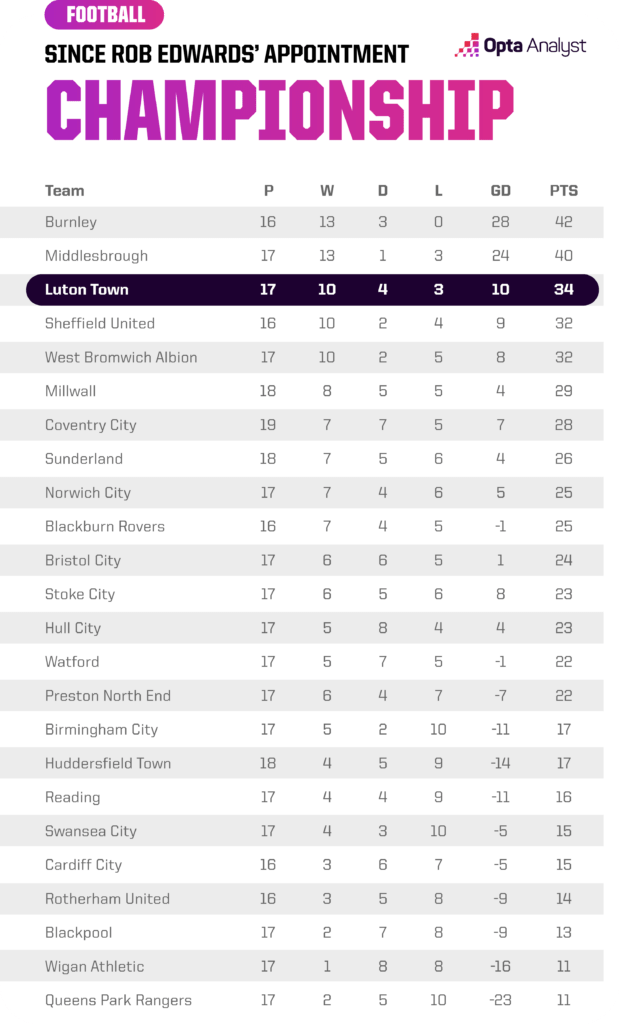
Since he arrived at the club on 17 November, Luton have picked up 34 points in 17 matches at a rate of two points per game. Only runaway leaders Burnley (42) and automatic promotion-chasing Middlesbrough (40) have won more points across this period, while he’s improved on Jones’ start to 2022-23 (1.47 ppg).
By installing a familiar style from his Forest Green season – which he was hamstrung from embedding at Watford – Edwards has made Luton serious contenders for promotion to the Premier League this season.
Pump It Up
Luton don’t rely on having possession, it’s not a hugely important point to their gameplan. Overall, this season their average possession figure in the Championship is 44.8%, which 18th-lowest out of the 24 clubs. It’s been slightly higher under Edwards (46.7%) than it was under Jones (42.7%) this season, but keeping the ball isn’t vital to Luton. Getting the ball into the final third of the pitch is much more important.
Field tilt is a metric to show the territorial dominance between teams. Put simply, it measures the share of possession a team has in a game, considering only touches or passes in the attacking third. It can be useful when trying to understand which team is more dominant in games, rather than looking at overall possession, mainly as it looks at how teams are able to get the ball into areas that matter.
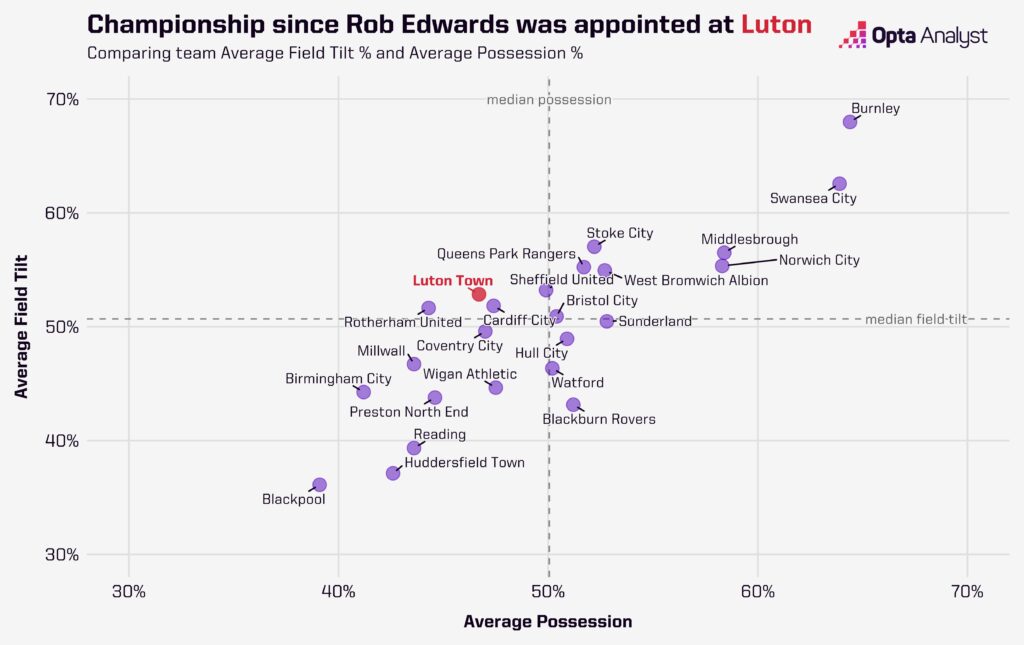
Under Edwards, Luton are one of only four Championship sides to have averaged less possession than their opponents but have a field tilt percentage higher than the opposition (52.8%). Essentially a philosophy of not keeping possession for the sake of it deeper on the pitch, but quickly getting in areas that can harm the opposition.
Luton average just 2.6 open-play sequences per game of 10 or more passes in the Championship during Edwards’ tenure, which is only higher than three sides – Blackpool (1.5), Birmingham (1.9) and Rotherham (2.0), all three of which are in the bottom eight of the Championship table. Compare this to the only two teams above Luton in the table since Edwards came into the club – Burnley (17.3) and Middlesbrough (12.4) – and it shows how dramatically different methods can produce league points.
Getting the ball into the final third of the pitch without taking many passes to do so isn’t anything new, and Watford fans certainly can’t accuse Luton of having an ugly style of play – their best ever manager in our best ever era gleaned success from these methods, after all.
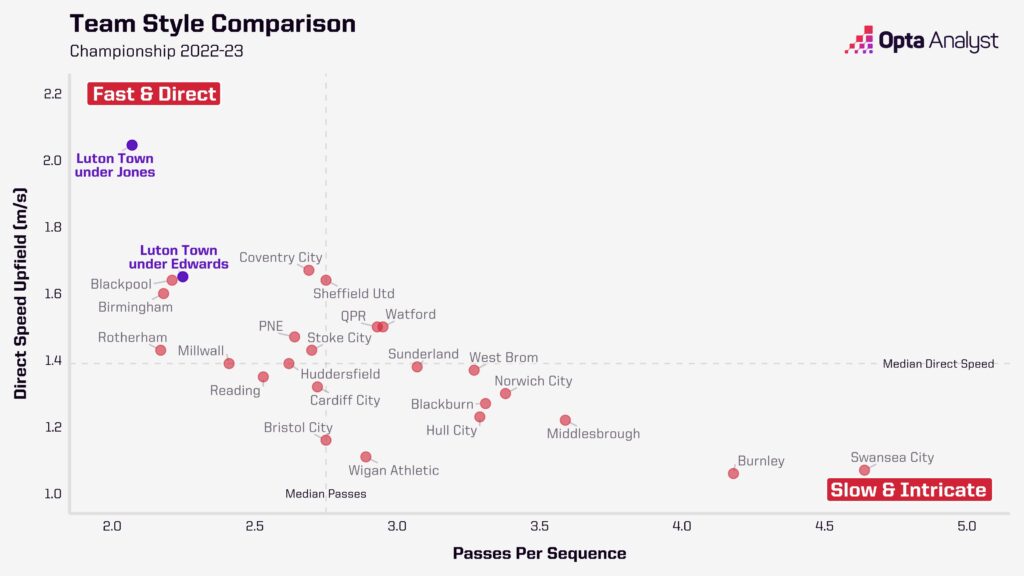
Luton haven’t been as direct under Edwards as they were under Jones in 2022-23, but Luton are still one of the most direct and fast-paced sides in the Championship this season. The Hatters still average under 2.5 passes per open-play sequence of play under their new boss, but they have become less direct in the speed at which these sequences are launched upfield.
Since Edwards was appointed, Luton are one of only six teams to have played over 20% of their passes long (30 yards or more), while only Rotherham (43.8%) have seen a higher proportion of their open-play passes end in the attacking third of the pitch than they have (39.7%).
Their strikers are the usual target of these, with only Andry Carroll and Tom Bradshaw being involved in more aerial duels per 90 among forwards in the Championship since Edwards came in on 17 November than Carlton Morris (8.8) and Elijah Adebayo (8.9).
Once the ball is in the attacking half of the pitch, Luton want to keep it there, even if they don’t have possession of it.
Under Edwards, Luton have the third lowest PPDA of 10.0 behind only Burnley (9.7) and Stoke (9.3) – PPDA totals the opposition passes allowed per defensive action outside of the team’s defensive third – while they also have the third most high turnovers in the Championship (151) across this period. Both are decent proxies for showing how intense a team presses in the attacking half of the pitch.
Of these high turnovers, the majority of the ball-winning is done by their hard-working central midfielders. Sixty five of the 151 (43%) have been made by the quartet of Jordan Clark, Allan Campbell, Pelly-Ruddock Mpanzu and Marvelous Nakamba.
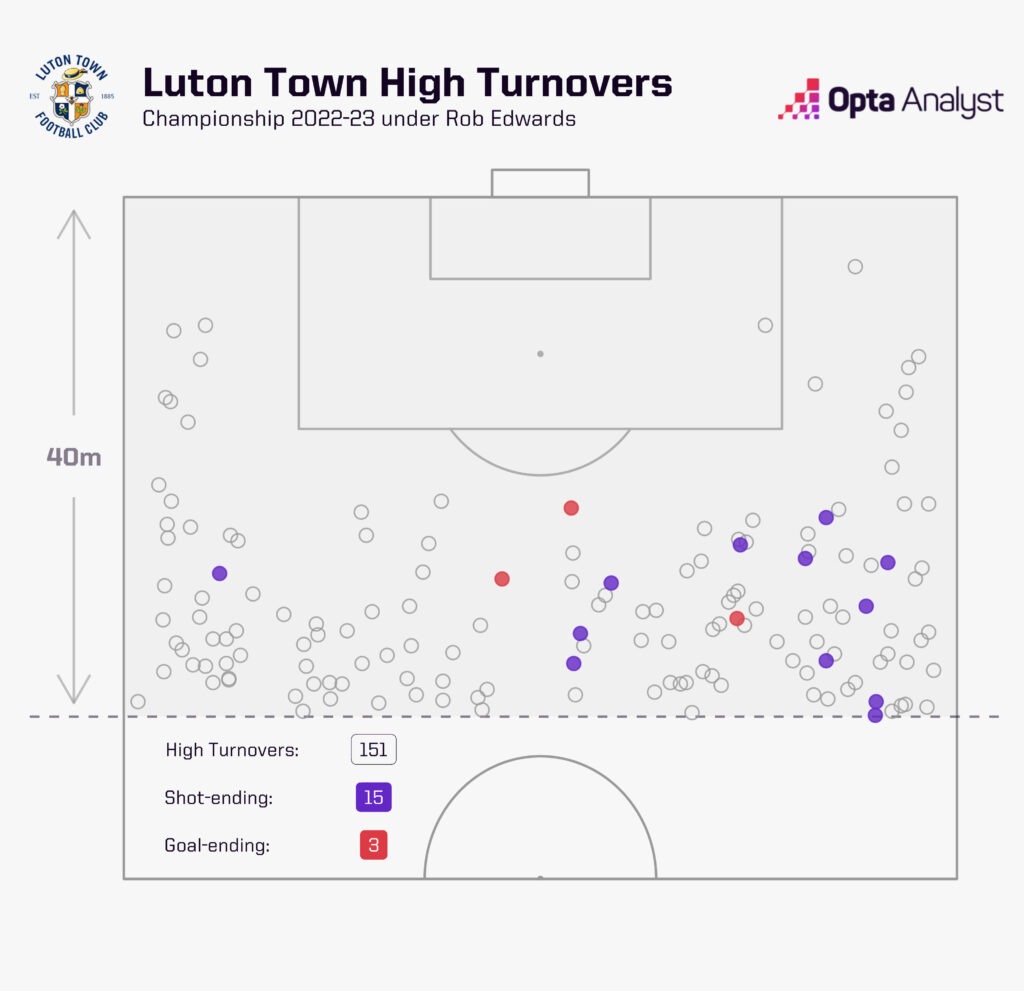
Stretching the Pitch
Under Edwards, no players have averaged more touches per 90 minutes at Luton Town than their wing-backs, Alfie Doughty (68.3) and Cody Drameh (67.6), while those two are also the only Hatters’ players to average at least 40 touches in the opposition half. On average, both players have over 60% of their touches in the opposition half – Doughty (64.4%) and Drameh (60.6%).
Luton suffered a blow with influential right-back James Bree’s departure to Southampton to join up with Jones in January, but as expected with Luton’s sharp player recruitment team, they quickly found an ideal replacement in Leeds’ loanee Drameh just three days later. Since Drameh’s debut on 31 January, the only two players to have reached double figures for chances created in the Championship at Luton are the 21-year-old right wing-back (13) and his left-sided team-mate Doughty (13), while across the whole season, Bree (0.28), Drameh (0.23) and Doughty (0.20) top the Luton leaderboards for xG assisted in the Championship.
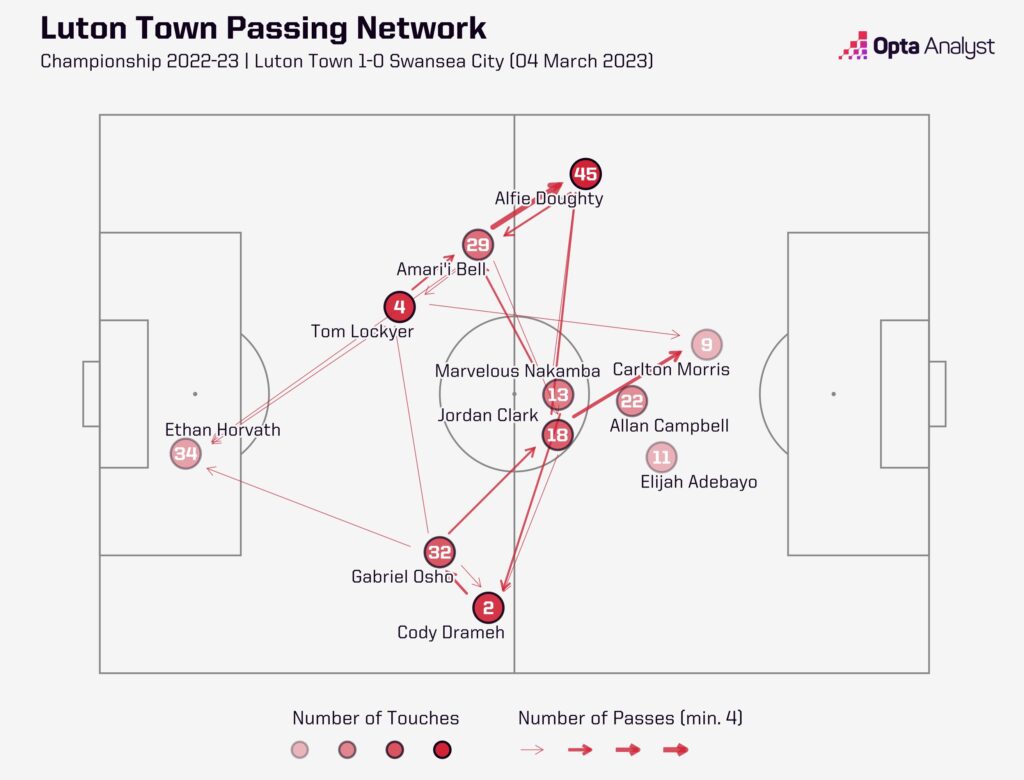
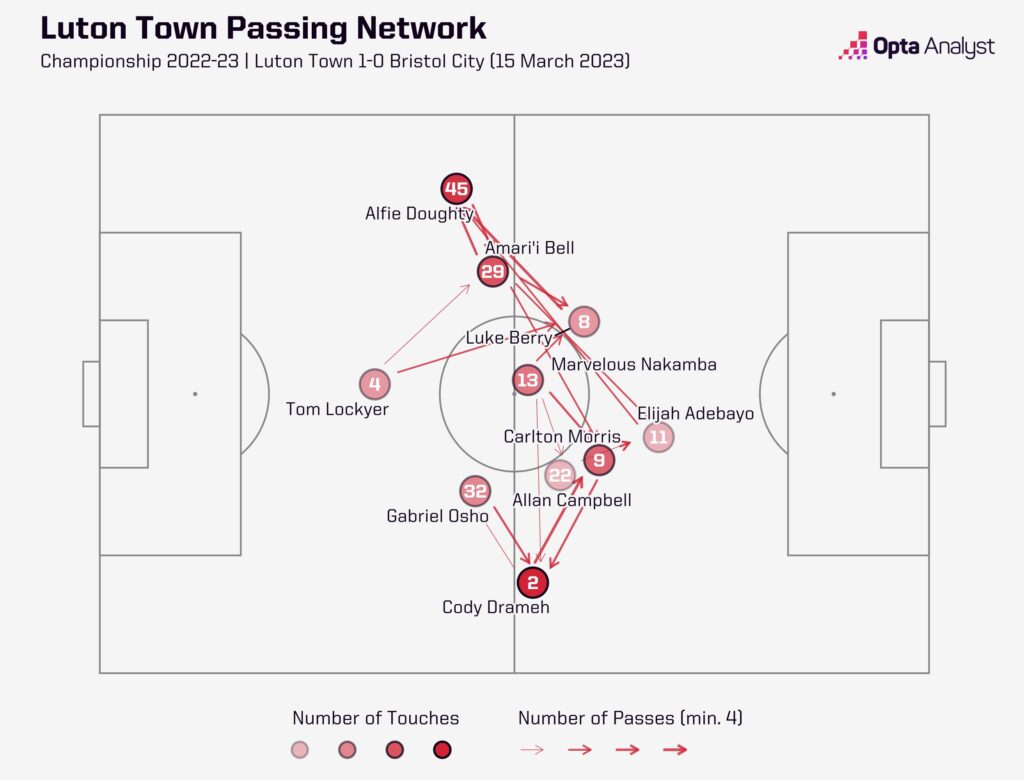
Looking at Luton’s passing networks from their most recent two Championship home games against Swansea and Bristol City, the importance of their two wing-backs in building passing sequence chains is clear to see.
In the two 1-0 wins, Morris grabbed the winner in both games – the goal against Swansea from a driven Doughty cross, the winner against Bristol City a header from a fantastic Drameh cross.
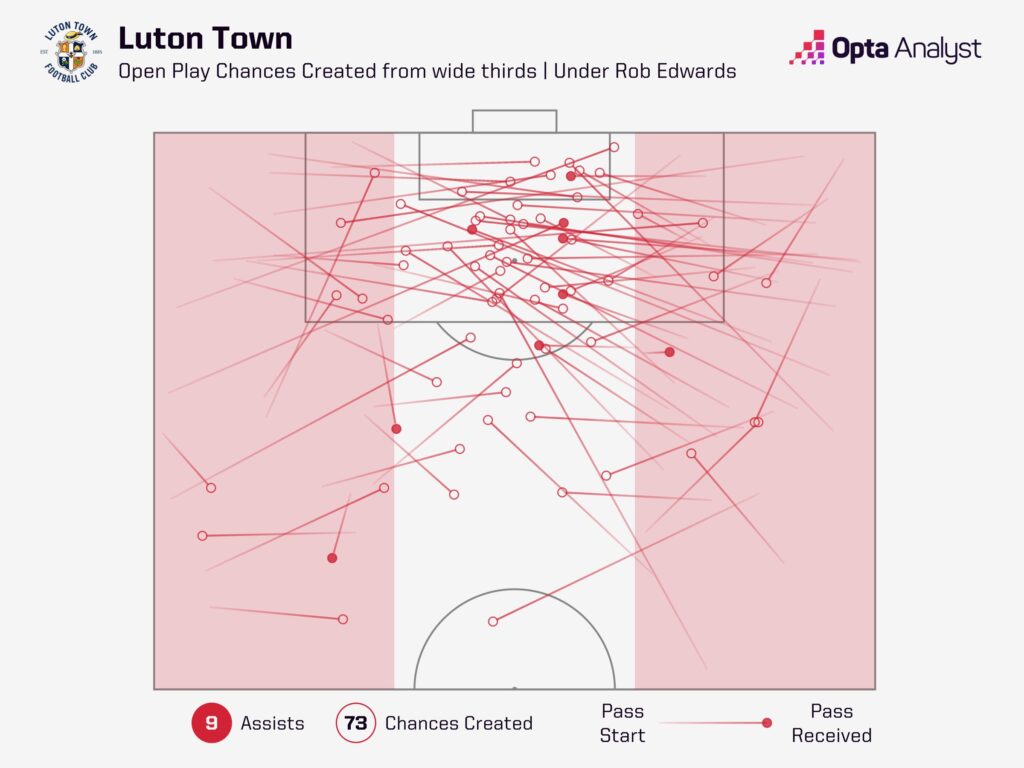
Getting the ball out wide for crossing opportunities is key to Edwards’ system at Luton. Since his appointment, only two teams have found a team-mate with more open-play crosses than Luton (51) in the Championship, while their total of 28 chances created from open play crosses is the fourth-highest.
And their crossing threat isn’t just limited to open play. Luton’s players have combined for the highest xG assisted total of any side in the Championship from both corners (5.0) and in-direct free kicks (2.8) in 2022-23 overall. Despite that obvious threat, their tally of eight goals from these set pieces – four corners and four from in-direct free kicks – is the third lowest in the Championship, while just two goals have been scored directly via pass or cross from those methods this season, and never from a corner, which may come as a surprise to Luton fans… or not.
Q: When are we going to score from a corner!?
— Luton Town ST (@lutontownST) March 7, 2023
RE: There is a lot of work that goes into set-pieces so we are hoping that very soon we will score from one. We practice them hard so hopefully it is coming soon!
For Luton, why wouldn’t you get the ball out wide and generate open-play crossing opportunities when you have a two-man attack formed of Morris and Adebayo…?
The Frontmen
Ask most Championship defenders which forwards they wouldn’t be looking forward to playing against at the weekend and there’s a fair chance that Morris and Adebayo would be regular mentions.
Both are strong and aerially dominant strikers that can bully opposition defenders, but are also intelligent at finding space inside the box to maximise scoring opportunities.
Their role in the team hasn’t differed too much between Jones and Edwards, although since the new manager came into the club, both strikers have seen more of the ball outside of the box than under Jones – Morris’ % of touches inside the box has fallen to 11.1% from 13.9% and Adebayo’s 16.5% to 12.3%. But this hasn’t affected their goal outputs, with both averaging a better minutes per goal ratio under Edwards.
Despite that drop, both Morris and Adebayo are strikers who thrive on receiving the ball inside the 18-yard box. Of players to have played at least 1,500 minutes of Championship football this season, Adebayo averages the fifth-most touches inside the opposition box per 90 (5.7) and Morris the sixth-most (5.4).
Both rarely get involved in the build-up to their own shots, too. Of Morris’ 75 open-play shot attempts, just five have seen him also involved in the move building up to the shot, while Adebayo’s 62 open-play shots have seen him involved in the sequence build-up just three times. Of the eight combined occasions that they have been involved in the build-up to one of their own goals, all eight have been quick one-twos with a team-mate.
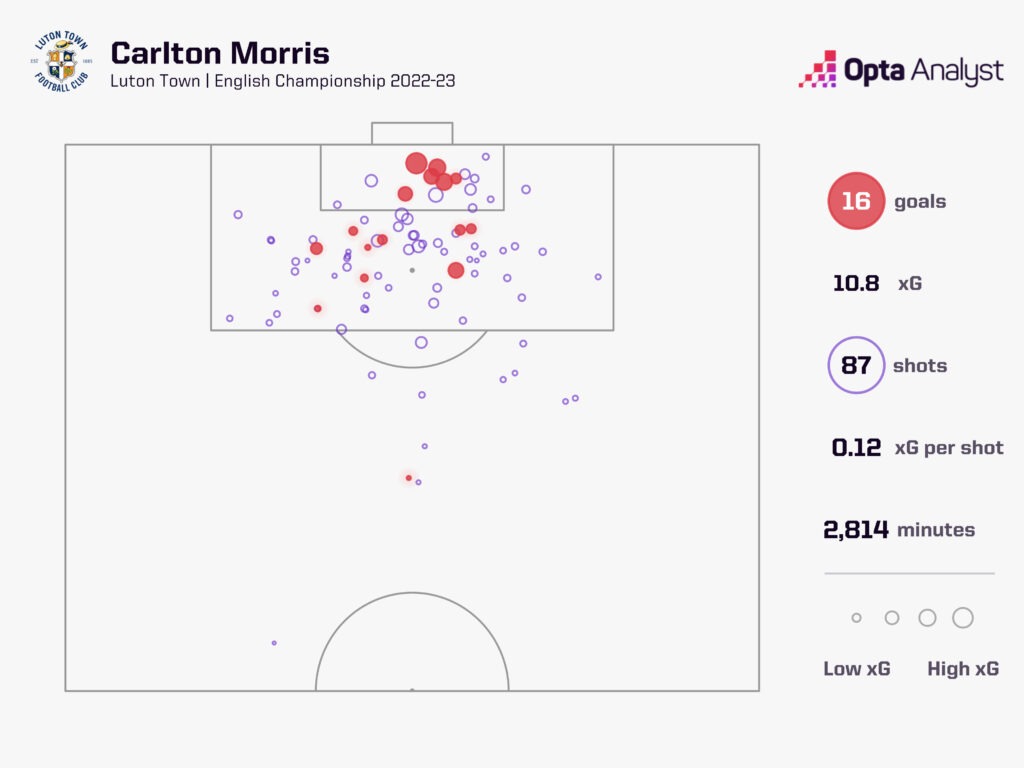
Another example of Luton’s excellent recruitment, Morris joined from relegated Barnsley in the summer for a reported fee of just £1.8m. He’s already repaid Luton with a seasonal career-best 16 goals in league competition, equalling Adebayo’s Championship tally from last season at the club. He needs just four more goals in the Championship this season to become the first Luton player to reach 20 league goals in a second-tier campaign since Brian Stein in 1981-82 (21), a year in which the Hatters won the title and secured a spot in the top-flight.
Both Adebayo and Morris were quite very quiet in Watford’s 4-0 rout of Luton earlier this season when Jones was still in charge of the club, attempting just three shots and one on target between them. With Edwards looking to prove Watford wrong and Luton hurt from that thrashing in October, there’s little chance they’ll be as quiet on 1 April.
Luton Town have never been a Premier League club, and should they end up being promoted this season, they’d be the first team to play in the non-league and work their way up to the top-flight in the Premier League era. Of course, football began before the invention of the Premier League and Luton know that better than anyone, as they were relegated from the top-flight the season before in 1991-92.
With the Bedfordshire club in such a rich vein of form with only eight games left to play before the play-offs, there’s every chance that the side with the smallest budget in the league could show the richer owners how it can be done sustainably.
Enjoy this? Subscribe to our mailing list to receive exclusive weekly content. And follow us on Twitter too.
